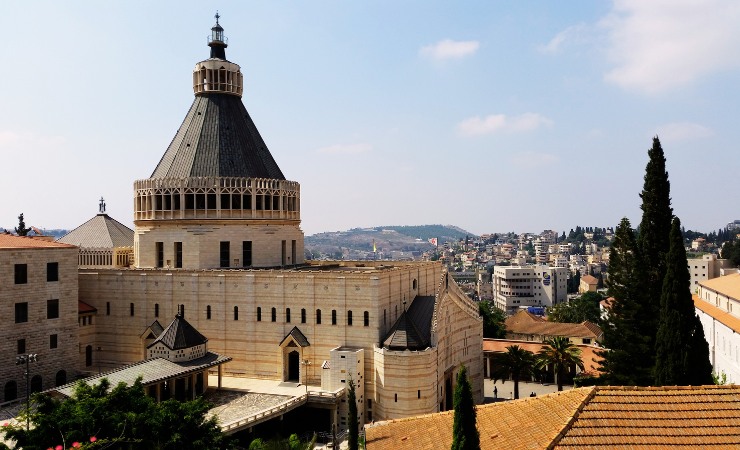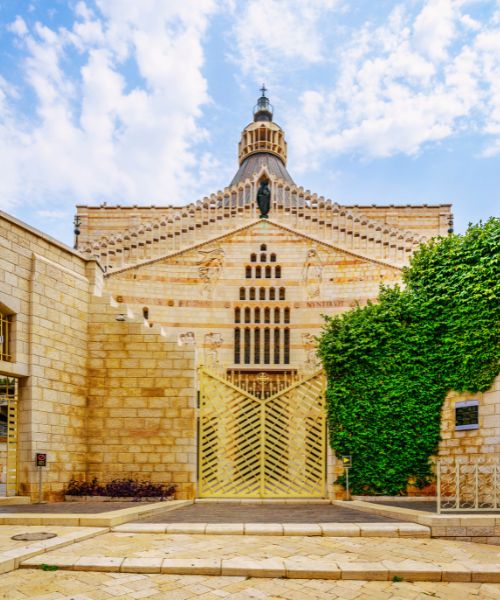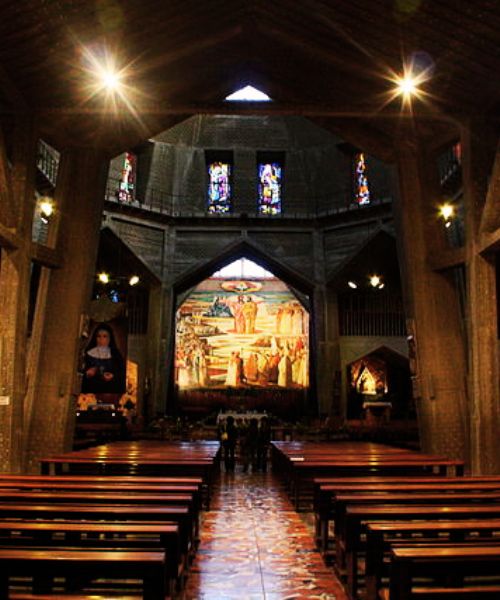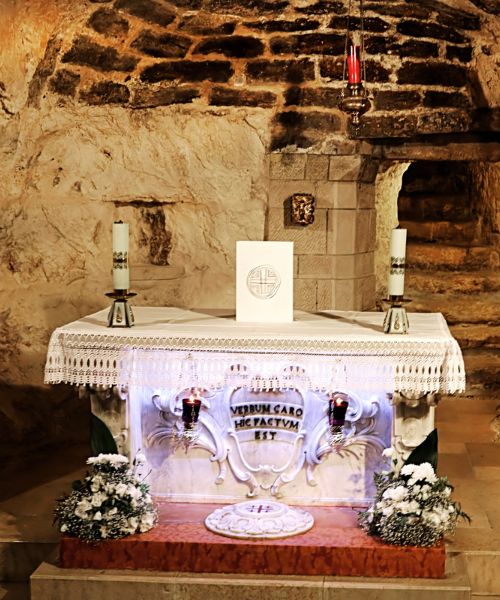The Church of the Annunciation: A Cornerstone in Christian Faith
Introduction
The Church of the Annunciation is a Catholic church that embodies not just a vital biblical event but also the amalgamation of the old and the new in its architectural grandeur.

Location
The Church of the Annunciation stands tall within the cityscape of Nazareth. It is the starting point of the Jesus Trail pilgrimage route. This church should not be confused with the Orthodox Church of Annunciation located next to the Fountain of the Virgin Mary (Mary’s Well).
Biblical Context
The Church of the Annunciation derives its name and importance from the biblical event known as the Annunciation, where the Angel Gabriel is said to have visited Mary, announcing that she would conceive Jesus, the Son of God. This divine encounter is recorded in the Gospel of Luke (Luke 1:26-38)
In the sixth month the angel Gabriel was sent from God to a city of Galilee named Nazareth, to a virgin betrothed to a man whose name was Joseph, of the house of David. And the virgin’s name was Mary. And he came to her and said, ‘Greetings, O favored one, the Lord is with you!’… And the angel said to her, ‘Do not be afraid, Mary, for you have found favor with God. And behold, you will conceive in your womb and bear a son, and you shall call his name Jesus
Main Features from an Archaeological Perspective
The Church of the Annunciation is an impressive structure, emblematic of the Brutalist-eclectic architectural movement prominent during the mid-20th century. This influence is clearly evident not only in its overall structural design but also in the distinctive artistic elements it houses. The Church integrates the historical elements of the site in a manner that highlights their significance, creating a seamless blend of past and present.
Lower Level: This level incorporates the archaeological remains of earlier structures, including the Byzantine and Crusader-era churches, and most notably, the grotto believed to be the home of Mary. Muzio skillfully incorporated these elements into the layout, offering visitors a direct encounter with the site’s historical fabric.
Upper Level: This houses the main area for worship, designed to accommodate a large congregation. The upper level is most indicative of Muzio’s modernist leanings, featuring minimalist lines, extensive use of concrete, and an imposing dome structure. The dome, adorned with an intricate depiction of Christ, symbolizes the heavens reaching down to earth, representing the divine intervention that occurred during the Annunciation. It resonates with the Lily flower, that is a symbol of the purity of the Virgin Mary.
The Façade and Courtyard: The façade portrays key figures and scenes from the Old and New Testaments. The adjacent courtyard houses an array of mosaics donated by Catholic communities worldwide, reflecting the universal devotion to Mary and the event of the Annunciation.
Muzio’s architectural vision for the Church of the Annunciation creates an eloquent dialogue between the past and the present, the earthly and the divine, and serves as a tangible expression of the continuity of faith across the ages.



Archaeological Layers of the Church of the Annunciation
The church is like a fascinating storybook, its chapters written across millennia. Each layer contributing to its current form and significance.
The Early Byzantine Church: The earliest evidence of a church at the site dates back to the Byzantine era, specifically around the 4th to 5th centuries CE. Archaeological findings, such as remnants of mosaics and structural elements, indicate the existence of an early Christian place of worship. This initial recognition and veneration highlight the long-standing belief in the site’s association with the Annunciation.
The Crusader Church: The Crusader period in the 12th century saw a transformation of the site. A grander, more ornate church was constructed, representing the architectural aesthetics and religious fervor of the time. The Crusader Church, however, suffered the same fate as the Kingdom of Jerusalem, falling into disuse and ruin after the Crusaders’ expulsion.
The Franciscan Presence: The Franciscan order, known for their guardianship of Christian holy places in the Holy Land, arrived in Nazareth in the late 17th century. They built a modest chapel over the grotto, believed to be Mary’s home. The construction marked a renewed period of protection and reverence for the site.
The Modern Church: As the 20th century rolled in, the decision was made to erect a new church. Various designs were considered (including the one submitted by Antonio Barluzzi), but ultimately, the architectural proposal of Giovanni Muzio, an Italian modernist architect, was selected. His design for the Church of the Annunciation envisioned a space that would not only preserve and highlight the archaeological remnants but also create a contemporary place of worship. Ground was broken in 1960, and after nearly a decade of construction, the new Church of the Annunciation was consecrated in 1969.
Nearby Sites
The Synagogue Church: This small church is traditionally identified with the synagogue where Jesus read the scriptures and announced his mission.
St. Joseph’s Church: Believed to be the site of Joseph’s carpentry workshop.
Mount Precipice: Mount Precipice offers panoramic views of the Jezreel Valley and Mount Tabor. It’s believed to be the site of the cliff where an angry mob intended to throw Jesus off after his bold proclamation in the Nazareth synagogue.
Nazareth Village: Nazareth Village is an open-air museum recreates a typical village from the time of Jesus, complete with costumed guides, traditional crafts, and ancient agricultural practices.



